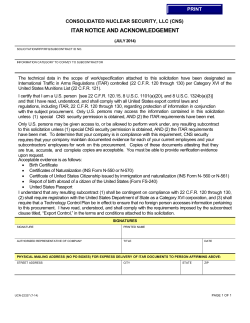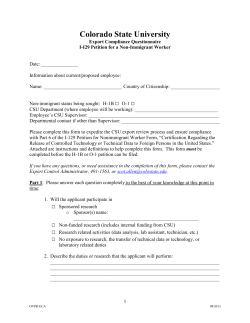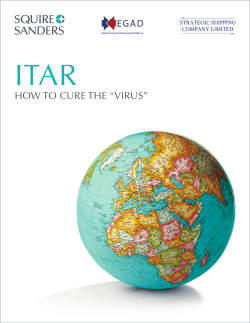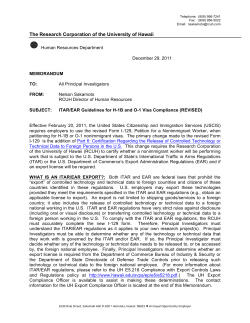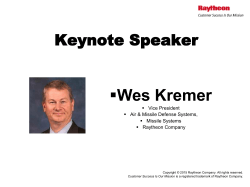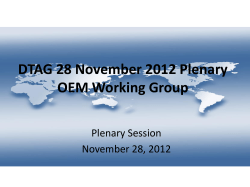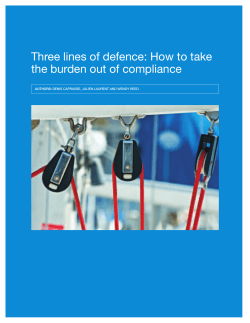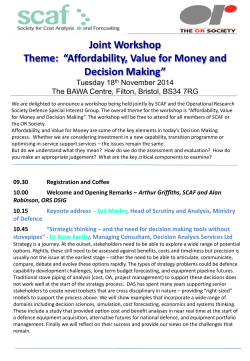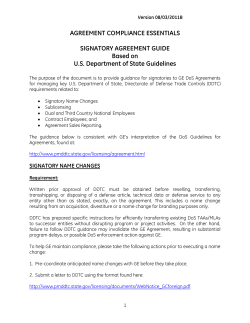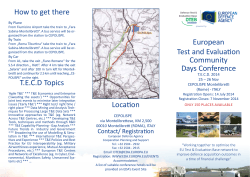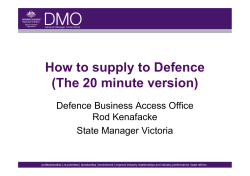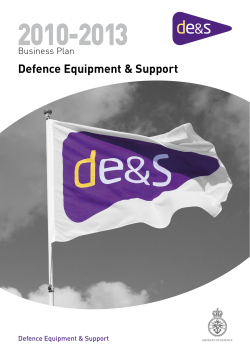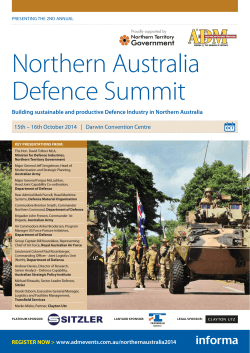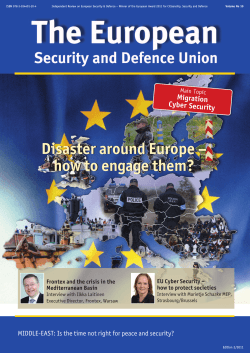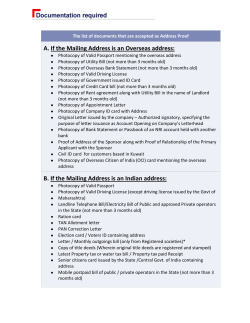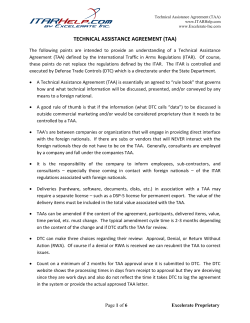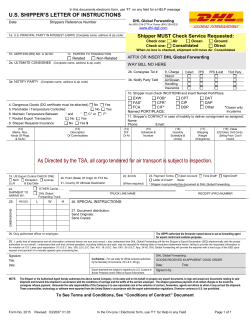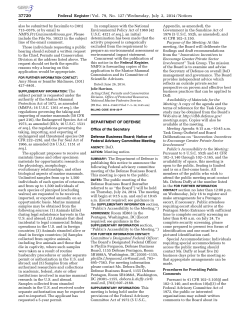
US TECHNOLOGY TRANSFER Presentation to Industry International Traffic in Arms Regulations (ITAR)
US TECHNOLOGY TRANSFER Presentation to Industry International Traffic in Arms Regulations (ITAR) Keith Alexander A/Director US Export Control Systems 02 6266 7664 0407 165 903 Sally Andrews Deputy Director US Export Control Systems 02 6265 2480 0488 619 033 Briefing Outline • ITAR – a quick overview • The importance of US defense export controls • Definitions • Types of Technology Transfer • Technical Assistance Agreements US Defence Export Controls • US Government controls access (including export) to ‘defense technology’ through the Arms Export Control Act (AECA) • Administration of this access is through the International Traffic in Arms Regulations (ITAR), which is the responsibility of the US Department of State (DoS) • List of controlled items identified in the US Munitions List (part 121 of ITAR) • In gaining access to US defence technology, Australia undertakes to utilise and protect these items in accordance with the ITAR. AECA Policy ITAR USML Rules Application US Defence Export Controls Our Obligations/Guarantees • US Technology (including data) must not be used for any purpose other than authorised unless prior Department of State (DoS) approval has been obtained. • US Technology (including data) must not be transferred by any means to a company or individual in Australia or overseas without DoS approval. • Australian products manufactured using US Technology (including data) must not be transferred to a company or individual in Australia or overseas, without DoS approval. Why is transfer of US Defence Technology Important to Australia? • Approximately 50% of inventory from US • Access critical to: – Maintain regional security edge – Interoperability with US forces • Important contribution to our industrial and defence scientific research capability Why Important to US industry? • ITT - $100m fine for illegal exports of military night vision tech to China, Singapore and the UK. • Boeing - $10m civilian fine; $2.5m mandated compliance program; corporate restructuring. • Lockheed Martin - $13m fine and mandated compliance program. • Loral - $20m fine; $6m compliance program; corporate executives also fined $100,000 for their roles in violations. • IBM East Europe/Asia Ltd - $8.5m for computer exports. Overview - what do US Regulations control? • US made products (items, hardware, software, technical data etc) on the USML including: – Products made from USML technology – Products containing USML manufactured parts and components • USML technology and technical data (including products developed from this information) • Remember - no de minimis Note: • The controls require an ‘authorisation’ to export or re-export • Authorisations come in the form of a ‘Department of State License’ Key Definitions • Controlled Unclassified Information (CUI) • USML • Defence Article • Defence Service • Technical Data • Public Domain • Export/Re-export Controlled Unclassified Information “Technology or technical information to which access or distribution limitations have been applied in accordance with applicable US national laws or regulations.” • Unique US Classification – no AS equivalent • Controlled as follows: •Use only for purpose authorised •Access to be limited iaw licence or agreement •Keep from further disclosure unless US exporter consents •Advise US exporter if unauthorised disclosure US Munitions List (USML) ITAR Part 121 • Categories: – Firearms, Ammunition, Missiles, Aircraft, Ships of War, etc • Significant Military Equipment (SME) – Marked * and/or classified - special export controls are warranted because of their capacity for substantial military utility or capability. Category IV—Launch Vehicles, Guided Missiles, Ballistic Missiles, Rockets, Torpedoes, Bombs and Mines *(a) Rockets (including but not limited to meteorological and other sounding rockets), bombs, grenades, torpedoes, depth charges, land and naval mines, as well as launchers for such defense articles, and demolition blocks and blasting caps. (See §121.11.) *(b) Launch vehicles and missile and anti-missile systems including but not limited to guided, tactical and strategic missiles, launchers, and systems. SME * (c) Apparatus, devices, and materials for the handling, control, activation, monitoring, detection, protection, discharge, or detonation of the articles in paragraphs (a) and (b) of this category. (See §121.5.) *(d) Missile and space launch vehicle powerplants. *(e) Military explosive excavating devices. *(f) Ablative materials fabricated or semi-fabricated from advanced composites (e.g., silica, graphite, carbon, carbon/carbon, and boron filaments) for the articles in this category that are derived directly from or specifically developed or modified for defense articles. *(g) Non/nuclear warheads for rockets and guided missiles. (h) All specifically designed or modified components, parts, accessories, attachments, and associated equipment for the articles in this category. Technical data and defense services related to above (i) Technical data (as defined in §120.10 of this subchapter) and defense services (as defined in §120.9 of this subchapter) directly related to the defense articles enumerated in paragraphs (a) through (h) of this category. (See §125.4 of this subchapter for exemptions.) Technical data directly related to the manufacture or production of any defense articles enumerated elsewhere in this category that are designated as Significant Military Equipment (SME) shall itself be designated SME. Category V—Explosives and Energetic Materials, Propellants, Incendiary Agents and Their Constituents *(a) Explosives, and mixtures thereof: (1) ADNBF (aminodinitrobenzofuroxan or 7-Amino 4,6-dinitrobenzofurazane-1oxide) (CAS 97096–78–1); (2) BNCP (cis-bis (5-nitrotetrazolato) tetra amine-cobalt (III) perchlorate) (CAS 117412–28–9); (3) CL–14 (diamino dinitrobenzofuroxan or 5,7-diamino-4,6-dinitrobenzofurazane-1oxide) (CAS 117907–74–1); Defence Article ITAR 120.6 • Any item or data listed in the US Munitions List. • Includes data in any physical form, models, mock-ups or other items that reveal technical data relating to US Munitions List items. • NOT basic marketing information on function or purpose or general system descriptions. Defence Service ITAR 120.9 • Furnishing assistance or technical data to foreign persons – For design, development, engineering, manufacture, production, assembly, testing, repair, maintenance, modification, operation, demilitarization, destruction, processing or use. • Military training of foreign persons – Including correspondence courses, technical, educational, information publications & media of all kinds, training aids, & military advice. Technical Data • ITAR 120.10 • Information on design, development, production, manufacture, assembly, operation, repair, testing, maintenance or modification of defense articles, – Includes blueprints, drawings, photographs, plans, instructions, documentation & software directly related to defense articles. • NOT general scientific, mathematical or engineering principles in the public domain, or basic function, purpose or general system description for marketing. Public Domain ITAR 120.11 • • • • Published information generally accessible/available to the public via: – Bookstores; newstands, subscriptions, public libraries; patent offices, – Open conferences, meetings, seminars, trade shows, exhibitions – Or through fundamental scientific or engineering research at an accredited institution of higher learning (published and shared) Through public release in any form (including internet), after approval by US government department Internet check with US exporter if uncertain Not if there are restrictions on publication, or research is funded by the US Government and controls apply. Export ITAR 120.17 • • • Sending or taking a Defence Article out of the US in any manner. Disclosing (including by oral or visual means) or transferring any Defence Article or Technical Data to a foreign person. Performing a Defence Service for a foreign person. Re-export (or retransfer) ITAR 120.19 • The transfer of Defence Articles or Defence Services (includes Technical Data) to an end use, end user or destination not previously authorised. Types of Technology Transfer Visits to US DoD & Contractor Facilities US DoD & Industry Briefings in Australia Cooperative Development/ Production Direct Commercial Sales (DCS) US Technology Transfer Trade Shows, conferences etc Foreign Military Sales (FMS) Release of Technical Information/ Publications Direct Commercial Sale (DCS) 1 2 US Industry Info Exchange only after TAA approval AS Industry DMO (The Commonwealth) End-user Export Licence and associated agreements US Government DoS, DoD Agreements ITAR Part 124 & 125 • Technical Assistance Agreements (TAA) • Manufacturing License Agreements (MLA) • Warehouse and Distribution Agreements (WDA) Technical Assistance Agreement (TAA) • A TAA is a contract between the parties involved in the technology transfer. It references the ITAR and also defines: – role of the parties – what technology and services are covered – who can access the ITAR-controlled technology – where the technology can be physically located – any restrictions on how the technology can be used – any exemptions allowed – how long you have access to the technology • Can only be initiated by US defence industry • Overrides any contractual ‘technology transfer issue’ • Discussion permitted General Discussion All parties (no technology transfer) TAA Outline Process US Industry Drafts TAA All licensees review Draft TAA US industry submits to DoS US DoD Reviewed by DoS US Industry distributes for signature Effective once all parties sign Approved Provisos (?) Other Agencies Technical Assistance Agreement Issues to be aware of • Tell US industry that you MUST review the draft before submission to DoS • When to sign (provisos) • Exemptions are not automatic (must be called up in the TAA) Technical Assistance Agreement Who can access the information • Restrictions on Dual/Third Country National access, especially to following Proscribed countries: – • • • Afghanistan, Belarus, Burma, China, Cote d’Ivoire, Cuba, Democratic Republic of Congo, Eritrea, Haiti, Iran, Iraq, Lebanon, Liberia, Libya, North Korea, Sierra Leone, Somalia, Sri Lanka, Sudan, Syria, Venezuela and Vietnam (as at Apr 09). Exemptions for access – Australian DOD security clause (must be included to apply, AS Govt end-user) – NATO clause DOS Agreement Guidelines http://www.pmddtc.state.gov/ag_guidelines.htm Key Points • Understand the regulations and your responsibilities. • Establish good communications, engage US company early and often in the process, ask them questions if you are unsure (remember technology transfer is separate from IP) • Not all US companies are “consistent in interpretation” with the ITAR – often risk adverse • Allow adequate time Questions Keith Alexander A/Director US Export Control Systems 02 6266 7664 0407 165 903 Sally Andrews Deputy Director US Export Control Systems 02 6265 2480 0488 619 033
© Copyright 2025
